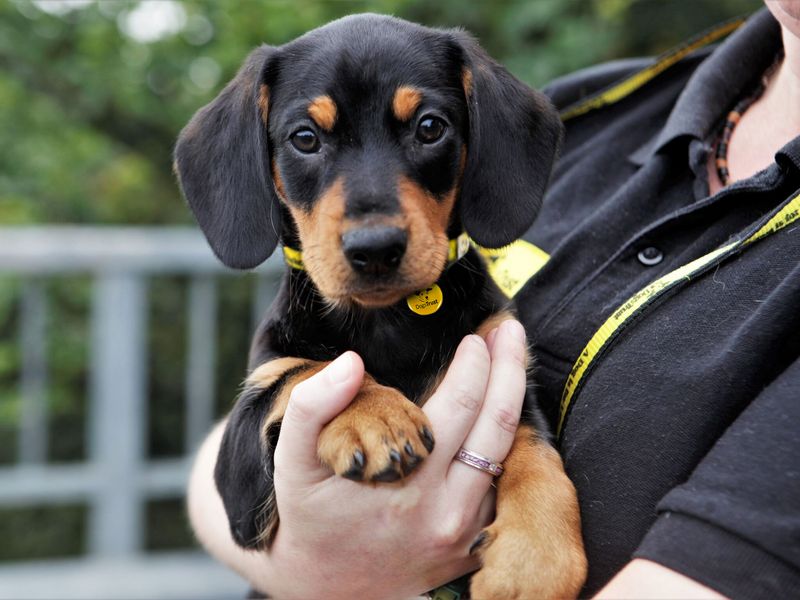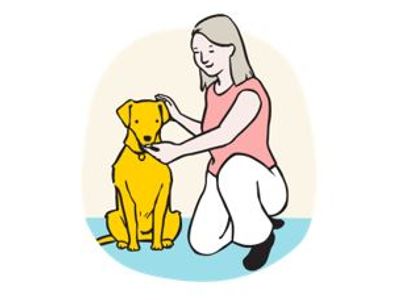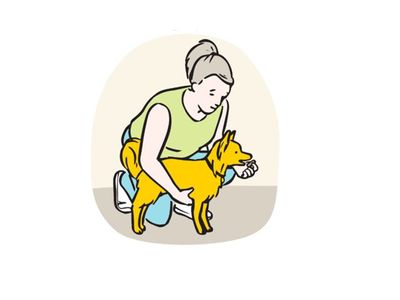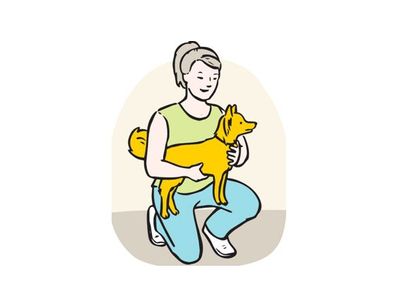How to properly pick up your dog
There are many reasons you may need to lift your dog including at the vet. Here's how to do it safely and properly.

There are lots of reasons you might need to pick up your dog: maybe to help them into a car or to put them on the vet’s table, so it’s essential to know how to do it properly.
It’s also important to teach your dog that being picked up, carried, and lifted onto a table isn’t anything to worry about. From a dog’s viewpoint, when they’re being carried, or placed high up, they can’t move away as easily from something worrying them. So, unless they’re very used to it, being picked up might be scary.
Teach your dog to be comfortable being lifted
It takes a lot of trust for your dog to be picked up comfortably. You need to teach them it’s nothing to worry about. Spend time at home gradually working through these steps.
Dogs learn through repeating things, so repeat each step several times, over multiple sessions. Make sure your dog is relaxed and confident before moving on. Praise and reward your dog all the way through to give them encouragement and reassurance.
Keep sessions short so your dog is always having fun (and you’re not doing too much lifting!) Spread short training sessions over the day and finish with a game to reward their effort. This way your dog will enjoy learning with you.
Before you start:
- Practice first without your dog. This prepares you for how you’ll move your body and manage your dog and their treats at the same time. Being well rehearsed helps your movements become deliberate and consistent so you can feel confident when you start teaching your dog.
- Be ready to read your dog’s body language. They might feel uncomfortable and back away when you lean or reach towards them. It’s not personal, they might just need a bit longer to learn that this is nothing to worry about and something to enjoy. Stop if they back away or if you see any signs they’re worried. Let them relax before you try again. More about dog body language.
My dog is large, can I lift them?
In the UK, Health and Safety guidelines for the workplace state that men may lift up to 25kg (3.9st) and women up to 16kg (2.5st) without assistance. Consider how much your dog weighs, their body shape and whether you feel safe and confident lifting them yourself, or whether you might need assistance.
Step-by-step guide to picking up your small dog or puppy
You will need: tasty treats some space a non-slip floor, or a bath or yoga mat. Safety first! Lifting anything, let alone something that moves, places your body under pressure. Avoid unnecessary strain by bending your knees to crouch down next to your dog. Bending forwards from your waist risks back injury. As you lift, keep your dog close to your body to remain stable and make your dog feel supported.
Kneel by your dog
Kneel or squat with your dog in front of you and give them some treats.
Position your hands
Slide your arm that’s closest to your dog's tail around their body so your hand sits either just along their side or beneath their tummy. If they’re small enough, tuck it in between their front legs. Gently stroke their chest with your hand closest to their face then give …
Position your hands correctly
If they’re comfy with this, you can progress a bit more. This time, slide your arm that’s closest to your dog's tail around their body in a scooping motion so they're almost gently sitting on the crook of your arm. Slide your hand either under their chest or between their …
Create a cue
Add in a word or phrase to let your dog know what is about to happen, such as “one, two, three, up”. Use the same phrase every time, so your dog learns to associate these words with being lifted. Say your chosen phrase, then slowly lift your dog briefly, just off the ground. …
Practice the manoeuvre
Say the phrase again and slowly lift your dog while you stand to your feet. Hold your dog close to your chest so that they feel secure. Then lower them to the ground and reward them with treats and praise.
Introduce moving while carrying them close to your body. Hold …
Step-by-step guide to lifting your dog onto a vet’s table
Being placed on a table can make a dog feel vulnerable because they aren’t able to easily get away if they’re worried. Teaching small dogs and puppies that being lifted and placed onto a table can be pleasant and enjoyable should help their confidence grow. If your dog finds this particularly difficult, ask your vet if they can be examined on the floor instead. You will need: tasty treats a sturdy low coffee table a sturdy higher table such as a dining room or kitchen table a non-slip mat, like a bath or yoga mat. Safety first! Picking a dog up to place them on a table might mean you need to twist your body or hold your dog away from your body, which could cause strain. Stand close to the table and move alongside it so you don’t need to twist to put your dog down. It’s a good idea to practice the movement without your dog first.
Practice on a table
Put your non-slip mat onto the lower table and scatter some treats on it. Pick up your dog in the way you’ve taught them, using your cue word. Place them on the table and allow them to enjoy the treats. Ideally you want to put them in the centre of the table, safely away …
Carefully lift them down
To get them down, guide them in to position alongside you and gently lift them back down. Reward them with praise and treats.
And repeat!
Repeat step one without treats ready on the table, Give your dog a treat from your hand instead. Repeat steps one, two and three with the higher table.
Even for dogs who are happy being lifted, there are times when you should avoid lifting them. If your dog is unwell, injured or recovering from surgery, you may need to avoid lifting them, or change the way you pick them up so you don’t put pressure on any sore part of their body.
When you’re at the vet, let the vet know where your dog is sore and ask if they can check your dog over without lifting them onto the table.






